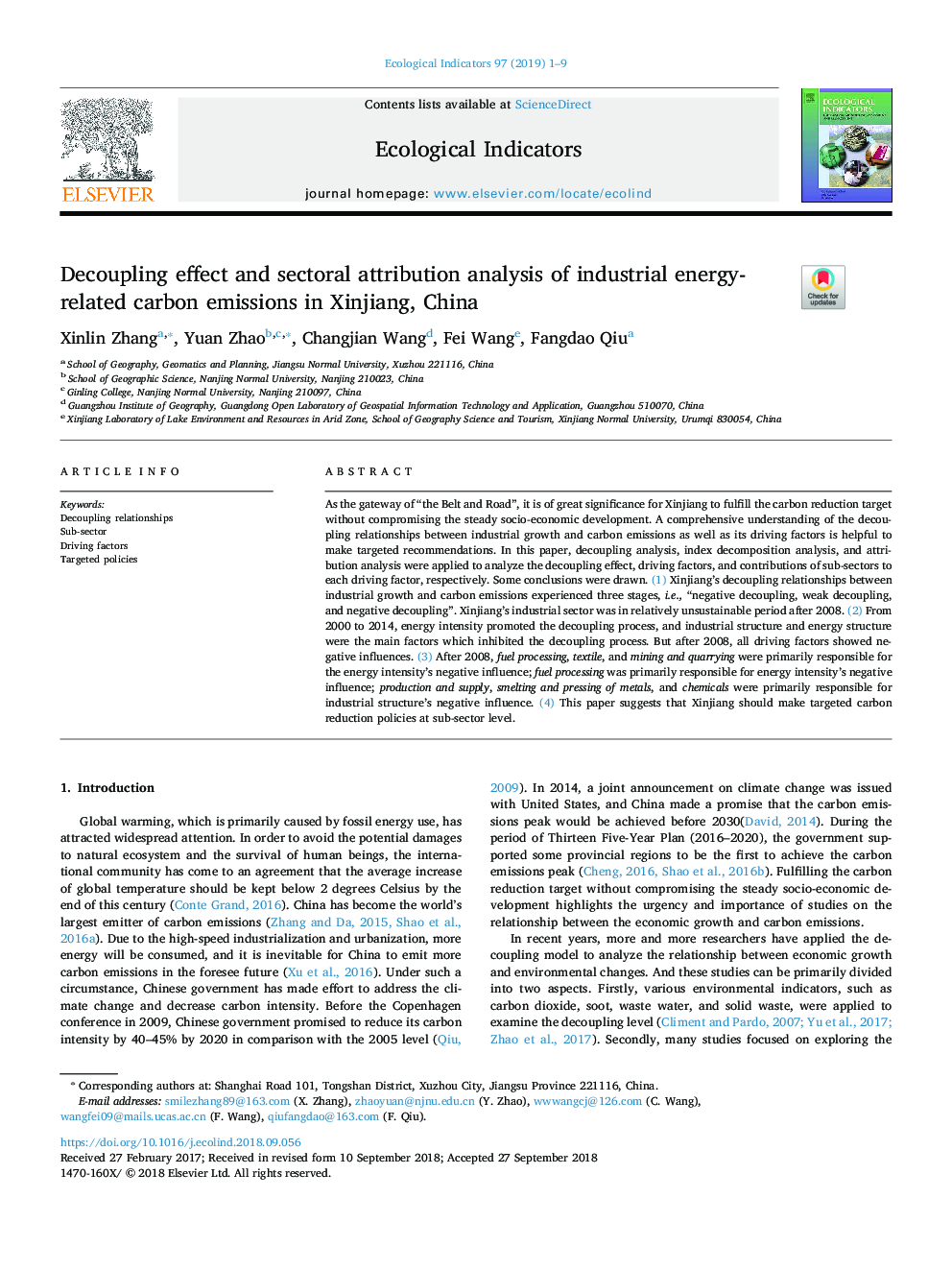| کد مقاله | کد نشریه | سال انتشار | مقاله انگلیسی | نسخه تمام متن |
|---|---|---|---|---|
| 11010252 | 1810984 | 2019 | 9 صفحه PDF | دانلود رایگان |
عنوان انگلیسی مقاله ISI
Decoupling effect and sectoral attribution analysis of industrial energy-related carbon emissions in Xinjiang, China
ترجمه فارسی عنوان
تجزیه و تحلیل اثر و تجزیه و تحلیل تخصیص بخش مربوط به انتشار انرژی کربن مرتبط با صنعت در سین کیانگ، چین
دانلود مقاله + سفارش ترجمه
دانلود مقاله ISI انگلیسی
رایگان برای ایرانیان
کلمات کلیدی
روابط جداسازی، زیر بخش، عوامل رانندگی، سیاست های هدفمند،
ترجمه چکیده
به عنوان دروازه کمربند و روادا، اهمیت زیادی برای سین کیانگ برای رسیدن به اهداف کاهش کربن بدون بروز توسعه پایدار اقتصادی و اجتماعی است. درک جامع از روابط جداسازی بین رشد صنعتی و انتشار کربن و عوامل موثر آن، توصیه های هدفمند را مفید می سازد. در این مقاله تجزیه و تحلیل تجزیه و تحلیل تجزیه و تحلیل تجزیه و تحلیل تجزیه و تحلیل برای تجزیه و تحلیل اثر تفکیک، عوامل رانندگی و سهم بخش های زیر به هر عامل راننده اعمال می شود. برخی نتیجه گیری ها انجام شد. (1) روابط جداسازی سین کیانگ بین رشد صنعتی و انتشار کربن به سه مرحله رسید، یعنی یک تفکیک منفی منفی، جداسازی ضعیف، و اختلاط منفی؟ بخش صنعتی سین جیانگ در دوره نسبتا ناپایدار پس از سال 2008 بود. (2) از سال 2000 تا 2014، شدت انرژی، فرایند جداسازی را ارتقا داد، ساختار صنعتی و ساختار انرژی عامل اصلی مهار پروسه جداسازی بود. اما بعد از سال 2008، تمام عوامل رانندگی تأثیر منفی داشتند. (3) پس از سال 2008، پردازش سوخت، نساجی، و معدن و معادن، عمدتا مسئول تأثیر منفی شدت انرژی بود؛ پردازش سوخت در درجه اول مسئول تأثیر منفی شدت انرژی بود؛ تولید و عرضه، ذوب و فشرده سازی فلزات و مواد شیمیایی در درجه اول مسئولیت تاثیر منفی ساختار صنعتی را بر عهده داشتند. (4) این مقاله نشان می دهد که سین کیانگ باید سیاست های کاهش کربن را در سطوح فرعی کاهش دهد.
موضوعات مرتبط
علوم زیستی و بیوفناوری
علوم کشاورزی و بیولوژیک
بوم شناسی، تکامل، رفتار و سامانه شناسی
چکیده انگلیسی
As the gateway of “the Belt and Road”, it is of great significance for Xinjiang to fulfill the carbon reduction target without compromising the steady socio-economic development. A comprehensive understanding of the decoupling relationships between industrial growth and carbon emissions as well as its driving factors is helpful to make targeted recommendations. In this paper, decoupling analysis, index decomposition analysis, and attribution analysis were applied to analyze the decoupling effect, driving factors, and contributions of sub-sectors to each driving factor, respectively. Some conclusions were drawn. (1) Xinjiang's decoupling relationships between industrial growth and carbon emissions experienced three stages, i.e., “negative decoupling, weak decoupling, and negative decoupling”. Xinjiang's industrial sector was in relatively unsustainable period after 2008. (2) From 2000 to 2014, energy intensity promoted the decoupling process, and industrial structure and energy structure were the main factors which inhibited the decoupling process. But after 2008, all driving factors showed negative influences. (3) After 2008, fuel processing, textile, and mining and quarrying were primarily responsible for the energy intensity's negative influence; fuel processing was primarily responsible for energy intensity's negative influence; production and supply, smelting and pressing of metals, and chemicals were primarily responsible for industrial structure's negative influence. (4) This paper suggests that Xinjiang should make targeted carbon reduction policies at sub-sector level.
ناشر
Database: Elsevier - ScienceDirect (ساینس دایرکت)
Journal: Ecological Indicators - Volume 97, February 2019, Pages 1-9
Journal: Ecological Indicators - Volume 97, February 2019, Pages 1-9
نویسندگان
Xinlin Zhang, Yuan Zhao, Changjian Wang, Fei Wang, Fangdao Qiu,
